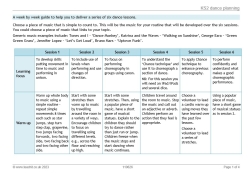Dance lesson plans

A scheme of work to help deliver a series of six KS2 lesson plans to cover the dance element of the PE curriculum.
Designed with the non-specialist teacher in mind, the lessons include activities to support children to create and perform choreographic sequences including canon and the chance technique.
The lesson plans include ideas for learning objectives, warm-ups, main activities, plenaries, teaching points, success criteria and AfL.
A sample lesson:
Learning focus:
To focus on performing choreography in groups using canon.
Warm up:
Start with some stretches. Then, using a popular piece of music, have a short game of musical statues. Explain to the children they should try to dance rather than just run or jump. Children freeze when the music stops and start dancing when music continues.
Main activity:
Show examples on YouTube of dancers dancing in canon.
Each pair should join another and come up with choreography to the chorus of their chosen music. This must include at least two sections of canon.
At the end of the lesson, split the class in half. One half watches the other and provides feedback. Children pick out a section of choreography using canon and explain how it enhanced the group’s performance.
Teaching points:
Canon is a technique where dancers copy a movement performed by another. An example of this is a Mexican wave. Other examples could include windmills, reaching up and bending down to the floor or jumping. More confident groups could use small sections of choreography and showcase them in canon.
Success criteria:
Canon to be used at least twice in chorus performance.
Children to work as a team to choreograph movements.
Plenary and AfL:
Cool down at end of the session with stretches and breathing exercises.
AFL: Question children on what canon is, why it is used and whether they can provide an example from another performance in their class or from the YouTube videos at the beginning of the session.
